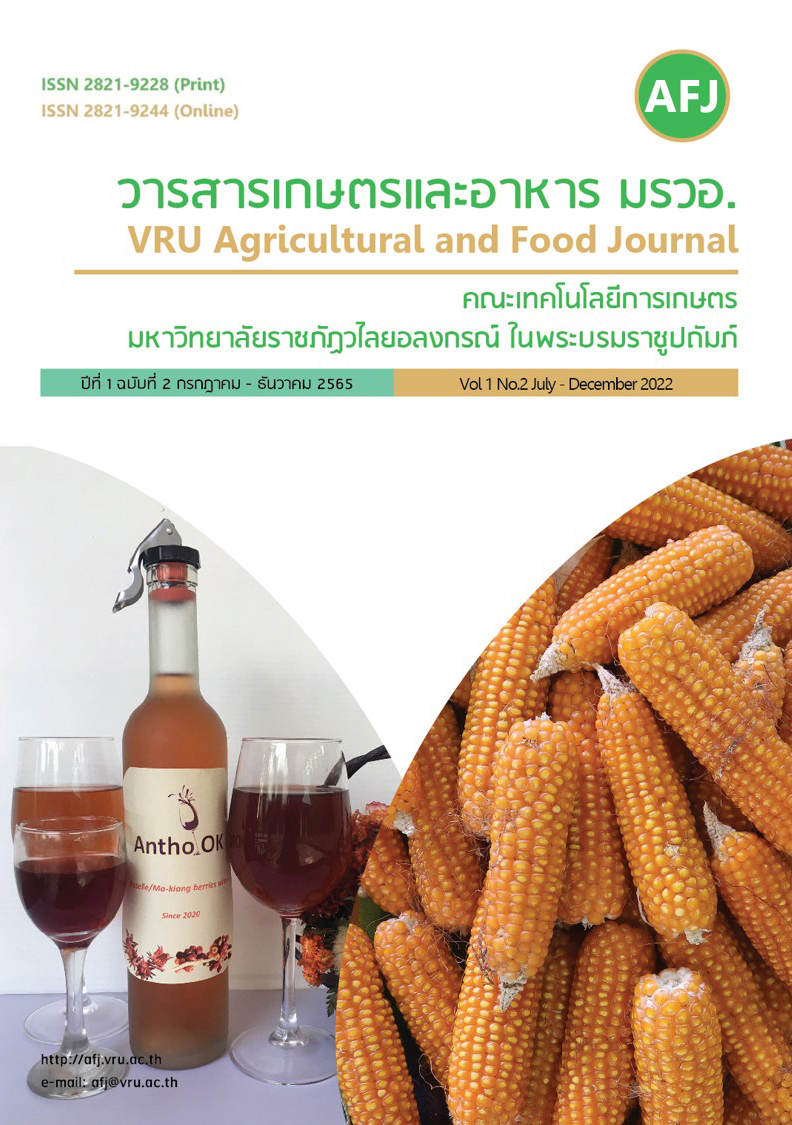การคัดเลือกข้าวโพดเลี้ยงสัตว์สายพันธุ์อินเบรดผลผลิตสูงและทนแล้งด้วยดัชนีการคัดเลือกของสมิธ
Main Article Content
บทคัดย่อ
การทดลองนี้มีวัตถุประสงค์เพื่อคัดเลือกสายพันธุ์อินเบรดในชั่วรุ่นที่ 7 ที่ให้ผลผลิตสูงและทนแล้ง โดยการใช้ดัชนีการคัดเลือกของสมิธช่วยในการคัดเลือก นำสายพันธุ์อินเบรดในชั่วรุ่นที่ 7 จำนวน 200 สายพันธุ์ ปลูกทดสอบในสภาพขาดน้ำในระยะออกไหมเปรียบเทียบกับสภาพให้น้ำปกติในฤดูแล้งระหว่างเดือนพฤศจิกายน 2564 ถึง มีนาคม 2565 ที่ศูนย์วิจัยพืชไร่นครสวรรค์ ผลการทดลองพบว่าสายพันธุ์อินเบรดมีผลผลิตในสภาพให้น้ำสม่ำเสมอเฉลี่ยเท่ากับ 330 กิโลกรัม/ไร่ และในสภาพขาดน้ำในระยะออกไหมเฉลี่ยเท่ากับ 212 กิโลกรัม/ไร่ และผลผลิตมีความสัมพันธ์ทางบวกกับดัชนีความทนแล้งและจำนวนฝักต่อต้น และมีความสัมพันธ์ทางลบกับคะแนนการแก่ของใบ คะแนนการม้วนใบ และจำนวนวันออกไหมและวันสลัดละออง ใช้ดัชนีการคัดเลือกของสมิธของข้อมูล 6 ลักษณะ ประกอบด้วยผลผลิตเมล็ด และลักษณะที่มีความสัมพันธ์กัน โดยให้น้ำหนักทางเศรษฐกิจเท่ากับ 1, 1, 1, -1, -1 และ -1 ตามลำดับ คัดเลือกได้ 20 สายพันธุ์ มีผลผลิตในสภาพขาดน้ำในระยะออกไหมเฉลี่ยเท่ากับ 487 กิโลกรัม/ไร่ ดัชนีการทนแล้งเฉลี่ย 1.04 จำนวนฝักต่อต้นเฉลี่ย 1 ฝักต่อต้น คะแนนการแก่ของใบเฉลี่ย 3 คะแนน คะแนนการม้วนใบเฉลี่ย 2 คะแนน และจำนวนวันออกไหมและวันสลัดละอองเฉลี่ย 0 วัน ซึ่งสอดคล้องกับเป้าหมายในการคัดเลือกที่ต้องการสายพันธุ์อินเบรดผลผลิตสูงในสภาพขาดน้ำในระยะออกไหม มีคะแนนการแก่ของใบน้อย คะแนนการม้วนใบน้อย และมีวันออกไหมและวันสลัดละอองเกสรใกล้เคียงกัน
Article Details

อนุญาตภายใต้เงื่อนไข Creative Commons Attribution-NonCommercial-NoDerivatives 4.0 International License.
บทความนี้ได้รับการเผยแพร่ภายใต้สัญญาอนุญาต Creative Commons Attribution-NonCommercial-NoDerivatives 4.0 International (CC BY-NC-ND 4.0) ซึ่งอนุญาตให้ผู้อื่นสามารถแชร์บทความได้โดยให้เครดิตผู้เขียนและห้ามนำไปใช้เพื่อการค้าหรือดัดแปลง หากต้องการใช้งานซ้ำในลักษณะอื่น ๆ หรือการเผยแพร่ซ้ำ จำเป็นต้องได้รับอนุญาตจากวารสารเอกสารอ้างอิง
Alvarado, G., A. Pacheco, S. Pérez-Elizalde, J. Burgueño and F. M. Rodríguez. 2018. RIndSel: selection indices with R. In Linear selection indices in modern plant breeding. Springer. Cham. pp. 243-256.
Department of Internal Trade. Maize coordinates 1005.90.90.002. Available from: URL:https://api.dtn.go.th, April 26, 2022.
Hazel, L.N. and J.L. Lush. 1942. The efficiency of three methods of selection. Heredity 33:393–399.
Hazel, L.N. 1943. The genetic basis for constructing selection indexes. Genetics 28: 476–490.
Kempthorne, O. and A.W. Nordskog. 1959. Restricted selection indices. Biometrics 15: 10–19.
Office of Agricultural Economics. 2022. Agricultural economic data. Available from: URL:http://www.oae.go.th, February 2, 2022.
Smith, H.F. 1936. A discriminant function for plant selection. In Papers on quantitative genetics and related topics. Department of Genetics, North Carolina State College, Raleigh, NC, p 466–476.
Thaitad, S. P. Grudloyma, T. Budthong, S. Vongsupathai, and J. Chanthaworn. 2013. Performance of hybrids maize under drought and low nitrogen conditions. In Proc.36th National Corn and Sorghum Research Conference, Nong Khai, Thailand, 4 – 7 June 2013. 269 – 275.
Vongsupathai, S., S. Thaitad, T. Budthong and P. Grudloyma. 2011. Precision phenotyping for improving drought stress tolerance in maize, pp. 17-18. In 11th Asian Maize Conference, Nanning, Guangxi, China, 7 - 11 Nov 2011.
Vongsupathai, S., P. Grudloyma, S. Thaitad, T. Budthong, K. Tadso and A. Phuto. 2013. The study on physiological traits for screening drought tolerance in maize. In Proc.36th National Corn and Sorghum Research Conference, Nong Khai, Thailand, 4 – 7 June 2013. 269 - 275.


